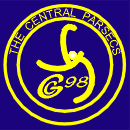

The Central Parsecs
Galactic Center Workshop '98
Tucson, Arizona, Sep. 7-11
email: gc98@mpifr-bonn.mpg.de




The Galactic Center (GC) has been one of the most interesting regions for scientific investigation by astronomers and astrophysicists since it was first identified as the source of extremely strong radio emission by Carl Jansky in 1932. The GC provides a unique laboratory for studying galaxies in general since it is the closest available Galactic nucleus and therefore can be studied with a resolution that is impossible to achieve in other galaxies. It also contains a wealth of unusual and unique phenomena both at the 10-100 of parsec scale and within the inner few parsecs.
Because of strong obscuration from the galactic disk, the central regions of the Galaxy are not accessible by conventional, optical astronomy, and therefore observational exploration of the GC had to await the era of Radio, Sub-millimeter and Infrared Astronomy, with high-resolution work coming only in the last few decades. The first (and still the highest resolution) observations come at radio wavelengths, as first demonstrated by the VLA and VLBI in the mid-1980's. More recently, however, vast improvements in technology have allowed high resolution observations of the GC in the near-infrared (NIR, 1-3 micron ), mid-infrared (MIR, 3-20 micron ), far-infrared (FIR, 20-200 micron ), sub-millimeter, and millimeter-resulting in remarkable progress towards obtaining the answers to long standing questions in the last 5-10 years. For example, the GC is now known to harbor by far the best candidate for a supermassive black hole: Sgr A* (2.5*106Mo). It also has been found to contain a collection of some of the most luminous stars in the Galaxy. It contains the most dense molecular clouds in the galaxy which seem to be interacting with both hot gas and strong ambient magnetic fields to produce filaments of nonthermal gas which are coherent over large (50-100 parsecs) distances. Therefore, the Galactic Center provides a complex laboratory for the study of galactic nuclei wherein each part seems to be intimately linked. In the last several years, large pieces of the puzzle have been uncovered, but the unified picture remains ambiguous.
Recent workshops specializing on research done in the Galactic Center (4th ESO/CTIO Workshop, March 10-15, 1996; IAU Symposium 184, August 18-22, 1997) have therefore presented a large variety of observational results on the inner several hundred parsecs of the Galaxy, at all available wavelengths, and with all available techniques. Although these workshops have successfully helped to distribute recent research results, and have highlighted the enormous growth in the quality and quantity of data available, little time has been available to discuss the impact of the results and to attempt to reach a consensus within the community on a number of controversial issues. Therefore, we have organized a workshop on Galactic Center research in Tucson, Arizona, September 7-11, 1998 for the express purpose of facilitating a broad discussion between observers and theorists on the newly available data and possible interpretations. We will include the most recent results from HST/NICMOS and ISO (the Infrared Space Observatory). The focus of the workshop will be on issues concerning the inner 100 parsecs of the Galaxy, and will focus on a number of controversial topics currently being studied within the GC community. We will therefore deviate from the conventional workshop format by reserving 45% of session time for facilitated discussions. The session chairs will therefore be required to take an unusually active role in preparing and leading their respective sessions.
The workshop and its scientific program is being organized by the editors of the Galactic Center Newsletter (GCNEWS), which was founded after one of the previous GC workshops to efficiently communicate new results in this field and link the scientific GC community closer together. GCNEWS is now an established and recognized source of information in this community, reaching a majority of scientists working in this field.


The conference is jointly organized by the Galactic Center Newsletter, the Sonderforschungsbereich 328 (Heidelberg), the Physics Department and the Steward Observatory of the University of Arizona, and the Max-Planck-Institut für Radioastronomie (Bonn).